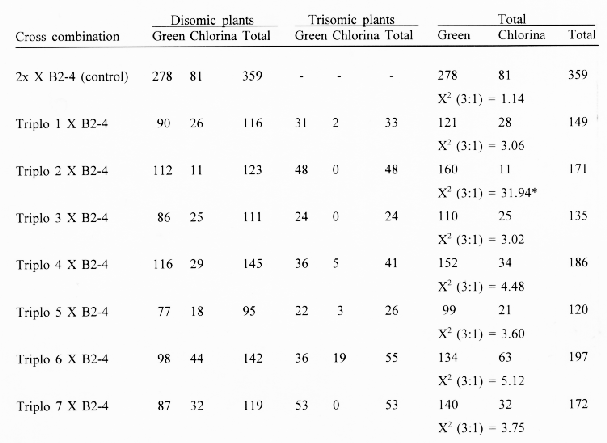

The chlorina mutant in Nigrinudum II (Stock no. B2-4) was obtained from the Colorado State University Genetic Center in Fort Collins, Colorado from the late Dr. T. Tsuchiya. It is a recessive mutant in a two-rowed barley of unknown origin. Because it has albino seedlings, the mutant was classified by Tsuchiya (unpublished) as white. As the leaves continue to grow, they become yellow green, and at maturity all leaves are light green. The mutant gene is a reliable marker and can be easily recognized. Trisomic analysis as described by Tsuchiya (1991) was used to associate this gene to respective chromosomes. The mutant was used as a male parent in crosses with the seven stocks in the trisomic series. A cross to a normal diploid plant was the control.
Various cross combinations and F2 segregations are shown in Table 1. The genetic ratios in segregating progenies in the trisomic which carries the chlorina gene should be different significantly from 3:1. It was shown that this ratio should be close to 17:1 (normal vs. recessive) for the entire progeny, and 8:1 for the disomic portion (Khush, 1973).
The gene from B2-4, in the F2 from crosses between triplo 2 X B2-4, exhibited a significant deviation from the 3:1 ratio (X2 = 31.94). There are no recessive homozygotes in the trisomic portion, indicating that the chlorina gene in B2-4 is most likely associated with chromosome 2.

References:
Kush, G. S. 1973. Cytogenetics of Aneuploids. Academic Press, New York. 301 p.
Tsuchiya, T. 1991. Chromosome mapping by means of aneuploid analysis in barley. pp. 361-384. In P. K. Gupta and T. Tsuchiya (ed.) Chromosome Engineering in Plants: Genetics, Breeding, Evolution Part A. Elsevier.